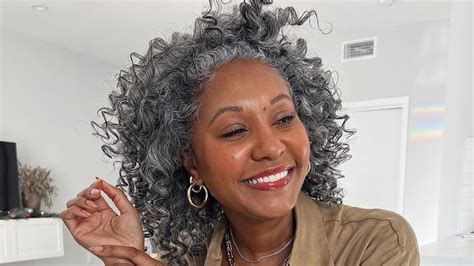Embracing the Silver Lining: Understanding Gray Hair
According to the CDC, approximately 50% of women over the age of 50 have gray hair. Gray hair is a natural result of the aging process, caused by a decrease in melanin production. While some women choose to dye their hair to conceal their gray roots, others are embracing their natural silver strands.

Motivations for Embracing Gray Hair
There are several reasons why more women are choosing to embrace their gray hair:
- Aging Gracefully: Gray hair can be seen as a symbol of wisdom and experience. By embracing their gray hair, women can avoid the pressure to conform to society’s standards of youth and beauty.
- Convenience: Dyeing hair is time-consuming, expensive, and can damage hair over time. By going gray, women can save time and money while reducing the risk of hair damage.
- Empowerment: Embracing gray hair can be a form of self-acceptance and empowerment. It challenges traditional beauty standards and encourages women to embrace their natural beauty.
Step-by-Step Approach to Transitioning to Gray
If you’re considering transitioning to gray hair, here’s a step-by-step approach:
- Start Gradually: Begin by letting your gray roots grow out. You can use dry shampoo or root touch-up products to blend the gray with the rest of your hair.
- Get Regular Trims: Regular trims remove split ends, which can make gray hair look dull and lifeless.
- Use Color-Enhancing Products: Certain shampoos and conditioners contain pigments that enhance gray hair and prevent brassiness.
- Embrace the Silver: Once your gray hair has grown out fully, embrace your new look. Experiment with different hairstyles and accessories to complement your gray strands.
Pain Points and Solutions
While embracing gray hair can be empowering, there are some common pain points that women may face:
- Harsh Chemicals: Dyeing gray hair repeatedly can damage hair and cause breakage.
- Unwanted Yellowing: Gray hair can sometimes turn yellow or brassy over time.
- Negative Stigma: Society may still associate gray hair with age and decline.
To address these pain points, consider the following solutions:
- Use Gentle Products: Opt for color-protecting shampoos and conditioners that minimize damage.
- Apply Toners: Toners neutralize brassy tones and keep gray hair looking its best.
- Challenge Stereotypes: Educate yourself and others about the beauty of gray hair and challenge ageist perceptions.
Comparison of Pros and Cons
Pros:
- Reduced time and money spent on hair coloring
- Enhanced self-acceptance and empowerment
- Aging gracefully and embracing your natural beauty
Cons:
- Potential for brassiness or yellowing
- Hair damage from repeated dyeing
- Social stigma associated with gray hair
Conclusion
Embracing gray hair is a personal decision that can be empowering and liberating. By understanding your motivations, addressing potential pain points, and transitioning gradually, you can embrace your silver strands with confidence and style. Remember, gray hair is a natural part of aging and can be a beautiful expression of your unique journey.
